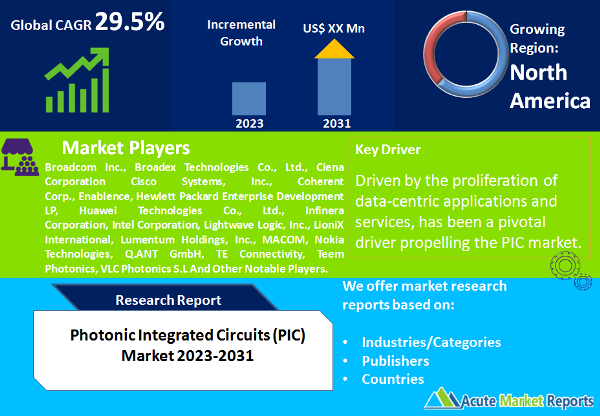
The photonic integrated circuits (PIC) market is expected to experience a CAGR of 29.5% during the forecast period of 2025 to 2033. The PIC market's growth is propelled by drivers such as the exponential growth in data traffic, advancements in telecommunication technologies, and the rising demand for energy-efficient solutions. However, the complex manufacturing and integration challenges underscore the need for innovative solutions to overcome production hurdles as the market progresses from 2025 to 2033, the PIC market is poised for continued growth, driven by technological breakthroughs, evolving communication paradigms, and the imperative to enhance data processing capabilities. The exponential surge in data traffic, driven by the proliferation of data-centric applications and services, has been a pivotal driver propelling the PIC market. The insatiable demand for higher bandwidth, enhanced connectivity, and rapid data processing capabilities necessitate innovative solutions to address the inherent challenges of data transmission. PIC technology, with its ability to integrate multiple photonic functions on a single chip, offers a transformative approach to meet these demands.

Advancements in Telecommunication Technologies
The relentless pursuit of advancements in telecommunication technologies has been a driving force behind the PIC market's growth. The evolution of 5G networks, the advent of high-speed optical communication systems, and the push towards ultra-high-definition video streaming have necessitated agile and efficient optical components. PICs, with their compact form factor and versatility, have emerged as a preferred solution to enable high-speed data transmission, wavelength multiplexing, and signal modulation. Company B's pioneering efforts in developing PIC-based transceivers have exemplified the potential of these integrated circuits in realizing the vision of seamless and high-capacity communication networks, thereby catalyzing market expansion.
Rising Demand for Energy-Efficient Solutions
The global emphasis on energy-efficient technologies and sustainable practices has propelled the demand for PICs. Traditional electronic circuits often incur substantial energy losses during data transmission and processing. PICs, on the other hand, leverage photonic elements that consume significantly lower power, making them an attractive option for energy-efficient computing and communication applications. The development of PICs using materials with enhanced optical properties, such as indium phosphide (InP) and silicon photonics, has further bolstered their energy-efficient attributes. Company C's initiatives in designing PICs for green data centers and power-efficient computing underscore the transformative potential of these integrated circuits in the pursuit of sustainability.
Complex Manufacturing and Integration Challenges
Amidst the flourishing growth, the PIC market encounters a complex restraint posed by manufacturing and integration challenges. The intricate processes involved in fabricating photonic components on a single chip demand specialized expertise and sophisticated fabrication facilities. Moreover, the seamless integration of different photonic functionalities, materials, and structures within a compact PIC framework introduces complexities in design, manufacturing, and testing. These challenges potentially impact production scalability and contribute to longer development cycles. The industry grapples with the imperative to strike a delicate balance between innovation and manufacturability, ensuring that PICs can be reliably produced on a commercial scale while maintaining high-performance standards.
Market Segmentation by Integration Type: Hybrid Integration Dominates the Market
The PIC market can be segmented by integration type, encompassing monolithic integration, hybrid integration, and module integration. In terms of revenue in 2024, hybrid integration emerged as the dominant segment, owing to its versatility in combining diverse photonic components from different material platforms. However, during the forecast period from 2025 to 2033, monolithic integration is projected to exhibit the highest Compound Annual Growth Rate (CAGR). The monolithic integration's potential to achieve higher levels of integration, compactness, and cost-effectiveness positions it for substantial growth.
Market Segmentation By Raw Material: Inp and SOI Dominates The Market
Market segmentation by raw material includes indium phosphide (InP), gallium arsenide (GaAs), lithium niobate (LiNbO3), silicon, silicon-on-insulator (SOI), and other materials such as silica-on-silicon and silicon dioxide (SiO2). In 2024, InP and SOI dominated the market in terms of revenue, owing to their exceptional optical properties and compatibility with high-speed communication systems. However, during the forecast period of 2025 to 2033, silicon is anticipated to achieve the highest CAGR. Silicon's widespread availability, established fabrication processes, and compatibility with complementary metal-oxide-semiconductor (CMOS) technology position it as a key contender for realizing cost-effective PIC solutions.
North America Remains as the Global Leader
Geographically, the PIC market demonstrates diverse trends, with varying revenue contributions and growth rates across regions. The Asia-Pacific region is poised to register the highest CAGR during the forecast period of 2025 to 2033. Rapid technological advancements, particularly in telecommunication and data center infrastructure, in countries like China and Japan, contribute to the region's robust growth prospects. However, North America is expected to maintain the highest revenue percentage during the forecast period, attributed to its strong research and development ecosystem, strategic partnerships, and early adoption of photonic technologies.
Market Competition to Intensify during the Forecast Period
Within the PIC market, several key players have emerged as industry leaders, each employing distinctive strategies to secure their competitive position and drive market share. These strategies encompass research and development investments, collaboration with academic institutions, market diversification, and strategic acquisitions. Leading companies such as Broadcom Inc., Broadex Technologies Co., Ltd., Ciena Corporation Cisco Systems, Inc., Coherent Corp., Enablence, Hewlett Packard Enterprise Development LP, Huawei Technologies Co., Ltd., Infinera Corporation, Intel Corporation, Lightwave Logic, Inc., LioniX International, Lumentum Holdings, Inc., MACOM, Nokia Technologies, Q.ANT GmbH, TE Connectivity, Teem Photonics, VLC Photonics S.L., and others have exhibited robust financial performance in 2024, fueled by their ability to offer innovative PIC solutions across various application domains. These players are expected to leverage their technical expertise, foster industry partnerships, and invest in emerging technologies to sustain growth from 2025 to 2033. The forecast period is anticipated to witness increased collaboration between industry stakeholders to standardize PIC design methodologies and establish compatibility with existing semiconductor processes.
Historical & Forecast Period
This study report represents analysis of each segment from 2023 to 2033 considering 2024 as the base year. Compounded Annual Growth Rate (CAGR) for each of the respective segments estimated for the forecast period of 2025 to 2033.
The current report comprises of quantitative market estimations for each micro market for every geographical region and qualitative market analysis such as micro and macro environment analysis, market trends, competitive intelligence, segment analysis, porters five force model, top winning strategies, top investment markets, emerging trends and technological analysis, case studies, strategic conclusions and recommendations and other key market insights.
Research Methodology
The complete research study was conducted in three phases, namely: secondary research, primary research, and expert panel review. key data point that enables the estimation of Photonic Integrated Circuits (PIC) market are as follows:
Market forecast was performed through proprietary software that analyzes various qualitative and quantitative factors. Growth rate and CAGR were estimated through intensive secondary and primary research. Data triangulation across various data points provides accuracy across various analyzed market segments in the report. Application of both top down and bottom-up approach for validation of market estimation assures logical, methodical and mathematical consistency of the quantitative data.
| ATTRIBUTE | DETAILS |
|---|---|
| Research Period | 2023-2033 |
| Base Year | 2024 |
| Forecast Period | 2025-2033 |
| Historical Year | 2023 |
| Unit | USD Billion |
| Segmentation | |
Integration Type
| |
Raw Material
| |
Component
| |
Application
| |
|
Region Segment (2023-2033; US$ Billion)
|
Key questions answered in this report